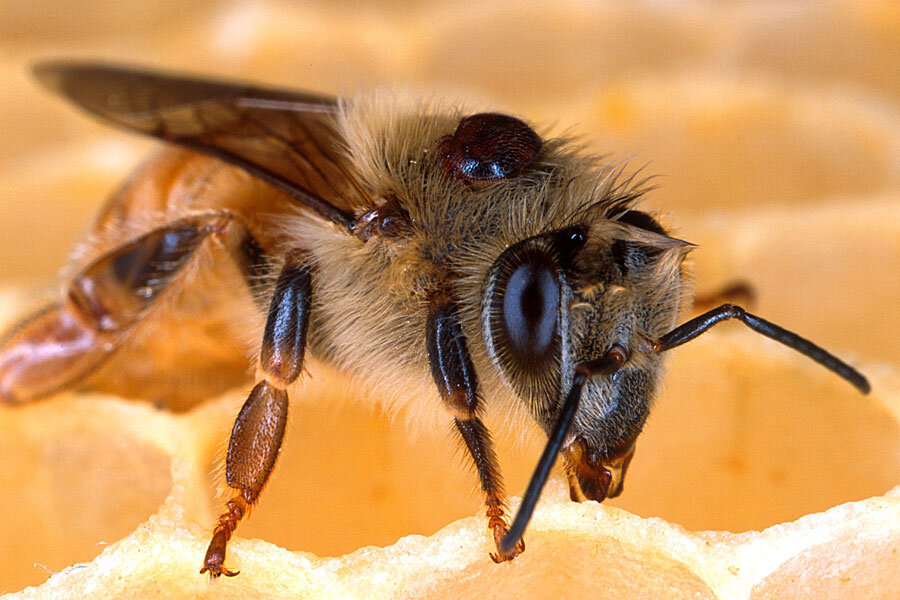Can Obama save the honey bees?
Loading...
Who could be against saving the honey bees?
For politicians, this is what's called an "Apple Pie" issue. And who pollinates the apple trees?
On Friday, Obama signed a presidential memo ordering the federal government to come up with a plan for protecting pollinators such as honey bees, butterflies, birds and bats. "The problem is serious and requires immediate attention to ensure the sustainability of our food production systems, avoid additional economic impact on the agricultural sector, and protect the health of the environment," Obama said in a memo was sent to Cabinet secretaries and agency heads.
Under Obama's plan the Environmental Protection Agency and USDA will lead a multi-agency task force to develop a pollinator health strategy and action plan within six months. As part of the plan, the USDA announced $8 million in funding for farmers and ranchers in five states who establish new habitats for honey bee populations, reports Reuters.
But for those who believe that the cause of the honey bee crisis has already been identified, this isn't much of an action step by the Beekeeper in Chief. It seems like another plan to create a plan to study the problem.
Friends of the Earth says that the US needs to immediately ban the use of neonicotinoids, a class of pesticides chemically similar to nicotine that has been linked to bee deaths.
"The administration should prevent the release and use of these toxic pesticides until determined safe," said Friends of the Earth president Erich Pica.
The organization is conducting a campaign and has collected more than half a million petition signatures asking Home Depot and Lowe's to stop selling plants treated with neonicotinoids (neonics).
The European Union has already suspended the sale of three neonic pesticides, after a review of the research. And some of the United Kingdom's largest garden retailers have stopped selling these pesticides.
Indeed, the evidence that neonics may be one of the causes of colony collapse disorder (CCD) is growing.
Last month, The Christian Science Monitor reported that two neonicotinoid insecticides that are widely used on crops can decimate honeybee colonies' winter survival rates, whether or not mites or parasites are present.
The two chemicals, imidacloprid and clothianidin, both block insects' central nervous systems, killing them by paralysis. Imidacloprid is the world's most widely-used insecticide, and has been registered for use in the US since the 1994; clothianidin was registered in 2003 by the US Environmental Protection Agency, which found that it had passed honeybee-specific toxicity tests.
Scientists studied the health of 18 bee colonies in central Massachusetts over a six-month period spanning the winter of 2012-2013. Six of the colonies were fed sugar spiked with sub-lethal doses of imidacloprid, six had theirs laced with clothianidin, and six less-unfortunate control colonies ate clean sugar, starting in October.All of the colonies went about their apian routines in good form throughout the fall. But by late January, six of the 12 poisoned colonies experienced collapses with CCD-like symptoms, like en-masse disappearance and the presence of un-hatched young.
So why isn't the US moving more quickly to ban neonics?
The answer lies, in part, in the value of neonicotinoids to farmers, animals, and the environment. This is one of the biggest selling classes of insecticides worldwide. Neonics play "a major role in pest management for pest control, agriculture and the ornamental plant protection industries. They serve as a group of highly effective insecticides with low risk to people and birds, which can be applied systemically to the soil," notes a Texas A&M AgriLife Extension blogger. This is a safer, better pesticide than many alternatives.
Another reason to hold off on a ban: There are still doubts that neonics are the principal cause of bee colony collapse.
A recent study by the Australian Pesticides and Veterinary Medicines Authority came to the conclusion that neonicotinoids are not a threat to Australian honey bees. Why? Because "Australian honey bee populations are not in decline, despite the increased use of this group of insecticides in agriculture and horticulture since the mid-1990s," says the report.
The Australian report agrees that neonics can be toxic to bees, but despite their use, Australian honey bee populations aren't suffering from bee colony collapse. It suggest that European and US researchers might look more closely at other possible causes.
In other words, while neonics might be one of the precipitating causes, they might not be the principle cause of CCD in the US and Europe. Saving the honey bees may require a more complex solution than banning one group of insecticides. And it may require more investigation into other possible causes of CCD, including parasites, viruses, climate change, bee nutrition, lack of genetic diversity and bee keeping practices.
Maybe, the US Beekeeper in Chief is taking the next best step to save the honey bees.








